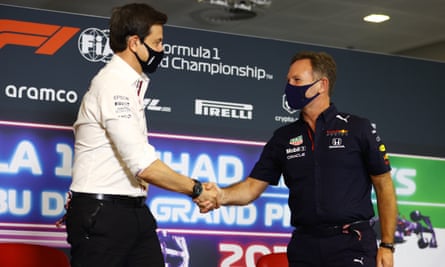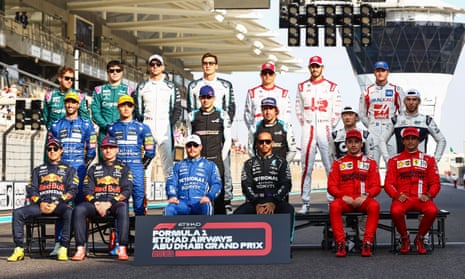American TV viewers weren’t exactly clamoring for a 10-part docuseries on Formula 1 racing, a sport that has previously been thought of in the US as the most tedious of all pastimes, literally going around in circles.
“Let’s be real folks, F1 is garbage racing in cars and technology none of us will ever dream to drive,” tweeted one former driver and Fox Nascar analyst in 2018, reflecting a wider mood in the US.
So when Formula 1: Drive to Survive, launched on Netflix in March 2018, it seemed doomed, especially as the show had no access to Mercedes and Ferrari – the main protagonists in the championship chase. This forced producers (who chided the title rivals for “letting the sport down”) to focus on the teams fighting for relevancy farther down the grid.
But, strangely, Americans didn’t much care about the main story becoming a B-plot. Instead, we swooned over Sauber’s Charles Leclerc and other heartthrob drivers; we felt for Claire Williams, the sport’s only female team principal; we salivated over the boss-level beef between Red Bull’s Christian Horner and Renault’s Cyril Abiteboul. Then we turned out for that November’s US Grand Prix in Austin, Texas, a quarter million deep, a slightly crowd than when organizers used a Taylor Swift concert to goose turnout in 2016.
That may well have been the moment Netflix knew they had a mega hit. Since Mercedes and Ferrari came aboard the following season, Drive to Survive has been doing what was once thought to be impossible: flipping Americans into Formula 1 fans.
More than 400,000 turned up for this year’s US Grand Prix. One million more watched the race on TV. Overall ratings for this season are up more than 40%, making this the most-watched F1 season in America. A second American race, through the streets of Miami, was added to the 2022 schedule – the first time the US has hosted two races since 1984. And it’s not just the US – the sport added an estimated 73 million fans last year, in markets including Brazil, China and France.
Sunday’s championship decider in Abu Dhabi averaged almost a million viewers, and its controversial ending kept social media users buzzing well into the NFL afternoon slate. Mostly, they argued about whether Max Verstappen’s last-lap upset of seven-time-world champion Lewis Hamilton was engineered as a ratings lead-in to Drive to Survive’s season four premiere in March.
Through a mix of broadcast footage, recorded interviews and dashcam angles, the series has taken what, in the US at least, has been seen as a sport for anoraks (what with all the obsessing over time splits and drag coefficients and tyre temperatures) and reimagines it as a high-stakes clash of big egos, tense power struggles and stunning betrayals.The producers understood a fundamental truth of American binge watchers: drama is our love language.
This is the brilliance of Drive to Survive, presenting F1 in terms a Real Housewives fan can process: Daniel Ricciardo is the guy you want leading your pub crawl. Lance Stroll is the spoiled son of a billionaire Bond villain. Christian Horner is married to Ginger Spice and yet Mercedes team principal Toto Wolff, aka Racing Arnold Schwarzenegger, lives rent-free in his head.
What’s more, the tension unravels against an ever shifting backdrop of private planes, paddock suits and supercars. “Formula 1 is the perfect sport to obsess over because there is no end to how far down the rabbit hole you can go,” wrote The Ringer’s Kevin Clark. “It reinvents itself constantly and is based on a million little edges that add up to big ones.”

The Netflix show has drawn hundreds of thousands of sports agnostics to F1, including a lot of women.
“On the weekends when there is no Grand Prix for me to watch while groggily drinking coffee on my couch at 9 am”, wrote The Atlantic’s Amanda Mull, “I now feel a bit disoriented.” The number of female attendees at this year’s Mexican Grand Prix – which follows right after the US race – rose by 30% compared to just the previous year.
Drive to Survive has also sparked a massive fan spike in the ever coveted 16- to 35-year-old demographic. Nielsen Sports research found that 77% of the growth was driven by this age group. Having so many young, telegenic drivers – not least, a 24-year-old champion now – is a casting coup.
Other American sports are in a rush to green light their own spinoffs: the PGA golf tour is currently filming a Netflix reality series that uses Drive to Survive as its blueprint, while Amazon has expanded their All Or Nothing sports reality franchise to include seasons on the Toronto Maple Leafs, Arsenal FC and the Brazilian national soccer team. But those other sports will have a hard time recreating a scene as high stakes as Haas’ Romain Grosjean nearly being burned alive in his cockpit after crashing out of the 2020 Bahrain Grand Prix.

Not everything in Drive to Survive tracks. Fans have decried the artistic license show creators have taken while stitching in-car radio snippets out of context and overheating some interpersonal conflicts. But those gripes pale in comparison to the white-hot outrage that followed Sunday’s finale. It’s enough to make you wonder if this is what F1’s managing director of commercial operations envisioned years ago when he said the sport “should create a little less predictability” as F1 pivoted “from motorsports company to a media and entertainment brand”.
For many F1 loyalists, the tail is now wagging the dog. With ESPN’s carriage rights set to expire after the 2022 season, Netflix has been bandied about as a potential successor. Such a move would do as much to consolidate F1’s audience as blur the lines between sport and entertainment, fact and truthiness. For the sports’ existing fans, it could spell the end of fairness and objectivity in its 75-year history. But it sure sounds like damned good TV.
